How Does a Cat Tracker Work?
Whether your kitty is an indoor cat, an avid adventurer, or an outdoor cat*, having a device that allows you to keep up with their location would be incredible. Thankfully there are many cat trackers out on the market that do just that!
But you are probably wondering, “How does a cat tracker work?” This article explains exactly how, covering the three main types of cat trackers in detail. After reading, you will be informed and able to make the best decision for your personal situation and for your beloved feline.
*I don’t recommend letting cats free roam outdoors. Catios and leashed walks are much safer alternatives.
Interested in an ad-free experience?
Come join the Trailblazers community and get access to ALL KittyCatGO articles with ZERO ads!

*Disclosure: This post contains affiliate links. If you make a purchase using one of these links, I will receive a small commission at no extra cost to you. This helps me to continue creating helpful content. Don’t worry – I would never recommend something I don’t like or use myself!
What is a cat tracker?
Simply stated, a cat tracker is a device that allows you to pinpoint your cat’s location. It allows you to be able to locate them if they get lost or are hiding in a clever spot you cannot find.
A tracker consists of two pieces – a small tag that typically attaches to your kitty’s collar, and a handheld locator device (oftentimes your cell phone or mobile device) that does the tracking.
Depending on how “smart” the cat tracker is, it may have additional capabilities, such as being able to track your cat’s activities – when they roam, the territory in which they roam, when and how much they sleep, and their active minutes. (More on these features later)
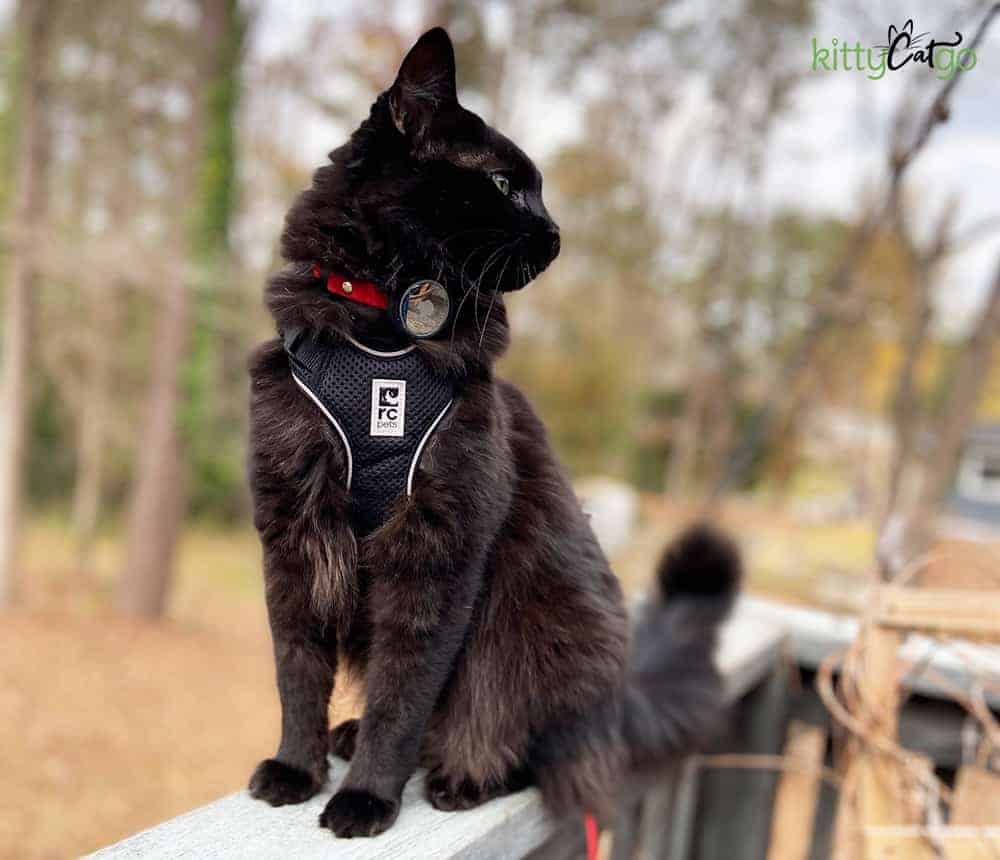
Why do I need a cat tracker for my cat?
There are many reasons and situations that warrant using a cat tracker. It’s important for you to evaluate your own situation and plans for how you and your cat will enjoy life together to determine if and when you should use a cat tracker.
Reasons you might consider using a cat tracking device:
- You and your cat spend a great deal of time on outdoor adventures and you want to have the peace of mind that you’ll be able to easily find your cat if they happen to slip out of their harness.
- Your cat is a free-roaming outside cat and you’d like to keep tabs on where they go and be able to find them if they don’t return home.
- You want to keep up with your cat’s activities – how much time they spend sleeping and how much time they are up and active.
- Your cat is indoor-only but is at risk of slipping outside and getting lost.
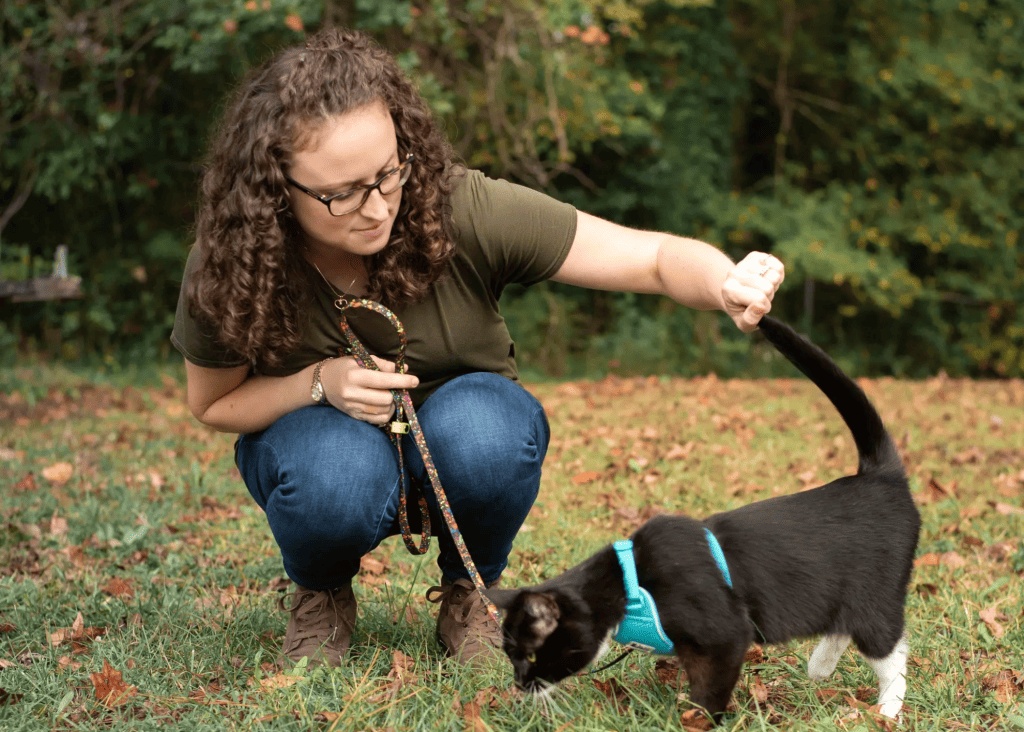
Is your cat meant for a life of adventure?
Let’s assess your cat’s personality to find out!
Types of Cat Tracking Devices
There are three main types of cat trackers: Global Positioning System (GPS), Radio Frequency (RF), and Bluetooth. Each style of cat tracking device functions a bit differently and has its own sets of pros and cons. The one that will be best for you will depend on the situations in which you plan to use it, your budget, and the features you’re looking for.
In the following section, you will find all the details so you no longer have to wonder, “How does a cat tracker work?”
GPS Cat Trackers
GPS trackers connect to a series of satellites to determine location. They utilize a process called trilateration, which uses the position of three or more satellites and its distance from them to determine latitude, longitude, elevation, and time. Basically, the satellites pinpoint the location of the tracking tag on your cat, which then communicates with the handheld locator device (which is often your cell phone), showing you where your cat is.
Because this type of tracking device uses Global Positioning Satellites, their range is usually incredibly large (some trackers claim they can track your pet across the entirety of earth!). In addition to their long distance range, many GPS trackers also have additional functionalities, like monitoring your cat’s rest, eating, exercise, and sleep so that you can have insights into your pet’s behavior and health.
GPS Tracker Pros:
- Works long distance
- Have several additional functionalities in addition to location tracking
- Usually pretty precise in determining location
- Uses your phone as the locator so you don’t have to carry an extra device
GPS Tracker Cons:
- Requires cellular or wifi connection, so they don’t function well in areas with poor cell service
- Comes with monthly and/or yearly subscription fees, making them a more expensive option
- They need to be charged more frequently
Popular GPS Tracking Devices
Tractice CAT Mini
- Size: 2.2 x 1.1 x 0.7 in
- Weight: 0.9 oz
- Price: $49.99 for the device – includes the Tractive device, charger, collar, clip, and mount
- Subscription plan required: ranges from $5-$13 per month, depending on the tier
- Range: Unlimited
Weenect XS
- Size: 2.3 x 0.9 x 0.5 in
- Weight: 0.95 oz.
- Price: $49.99 for the device – includes the Weenect XS device, silicone case, collar, and charging cable
- Subscription plan required: ranges from $4.72-$9.99 per month depending on the tier
- Range: Unlimited
Jiobit
- Size: 1.5 x 1.9 x 0.5 in
- Weight: 0.6 oz
- Price: $129.99 for the device – includes the Jiobit device, charging dock, and charging cable
- Subscription plan required: ranges from $8.33 – $16.99 per month depending on the tier
- Range: Unlimited (only within the United States)
RF Cat Trackers
Radio Frequency Trackers, or RF Trackers, use radio waves to transmit data. The tag which attaches to your cat’s collar, called the transponder, emits a frequency that is then tracked by the handheld locator device.
RF trackers are highly accurate, but they have a limited tracking range that can be further impeded by obstacles such as dense forests, city buildings, hills, mountains, etc. On the flip side though, they do not require a cell or internet connection, so they can function pretty much anywhere.
RF Tracker Pros:
- Highly accurate
- No monthly fees or subscription required
- Small and lightweight
- Long battery life – generally up to about 6 weeks
RF Tracker Cons:
- Limited range – typically between 400 ft to 2 miles
- Tracking can be hindered by obstructions
- Requires an additional locator device since you can’t track using your phone
Popular RF Tracking Devices
Girafus Pro-Track-tor
- Size: Tag – 1.5 x 1.0 x 0.4 in
- Weight: Tag – 0.28 oz
- Price: $84 – includes transmitter tag, locator device, batteries, and silicone cover
- Range: 1640 feet
Tabcat Cat Tracker V2
- Size: Tag – 1.18 x .79 x 0.35 in
- Weight: Tag 0.21 oz.
- Price: $99.99 – includes 2 homing tags, 2 splashproof cases, and 1 handheld tracking device
- Range: 500 feet
Marco Polo Pet
- Size: Tag 1 x 5 x 0.5 in – / Locator – 6 x 3.5 x 1.75 in
- Weight: Tag – 0.8 oz / Locator – 7.8 oz
- Price: $274.95 – includes hand-held portable locator, tracking tag, AC adapter, locator and tag charging cable
- Range: up to 2 miles
- Click here to read my review of the Marco Polo Pet Tracker.
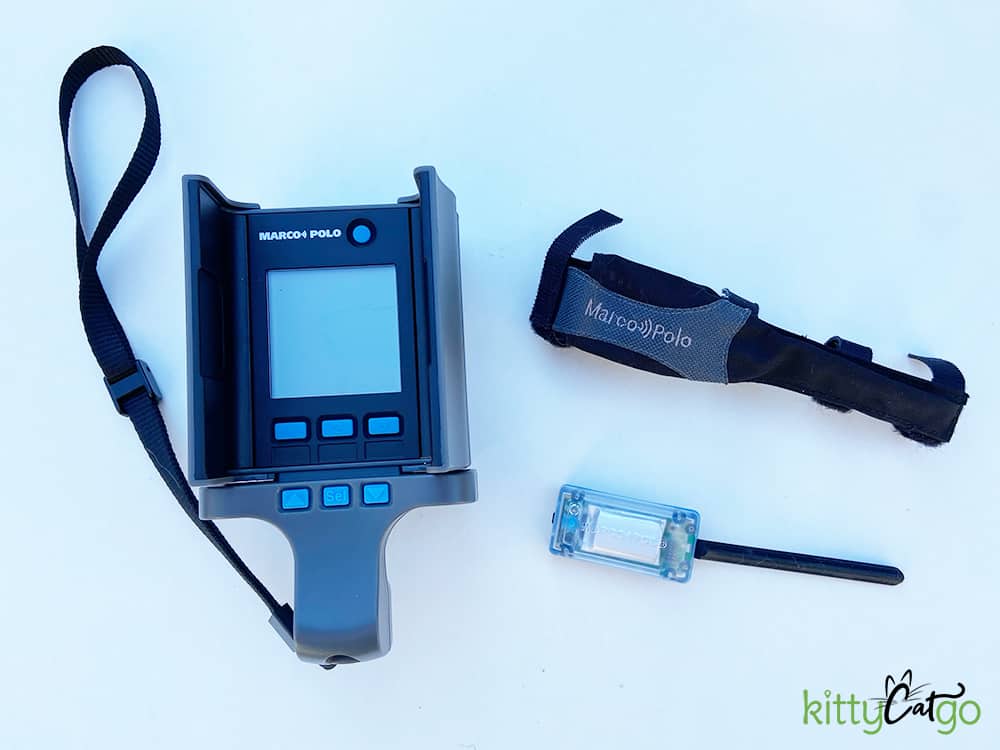
Bluetooth Cat Trackers
Bluetooth trackers use Bluetooth Low Energy (BLE) to wirelessly connect to your mobile device, regularly transmitting small amounts of data to your device through that connection. They easily partner with your phone, tablet, or computer – usually through an app.
Though most bluetooth trackers are designed to track small objects such as your keys, wallet, TV remote, or backpack for example, they can be used to track your cat. However, because they aren’t usually designed to be cat trackers, you might have to buy an additional accessory that will allow you to attach the device to your cat’s collar.
Bluetooth Tracker Pros:
- Inexpensive
- No monthly fees or subscriptions required
- Extremely long battery life – sometimes up to 1-2 years
- Connects to your phone, so no need for an additional device
Bluetooth Tracker Cons:
- Limited range of about 200 feet
- Susceptible to hacking
- Usually requires the purchase of an additional attachment device
- Not designed to be used as a pet tracking device
Popular Bluetooth Tracking Devices
Apple AirTag
- Size: 1.26 x 0.31 in
- Weight: 0.39 oz
- Price: $30 – includes tag only
- Range: ~30 feet, but potentially unlimited with the “Find My” network which uses other Apple devices with the tracking feature turned on
- Click here to read my review of the Apple Air Tag as a pet tracker.
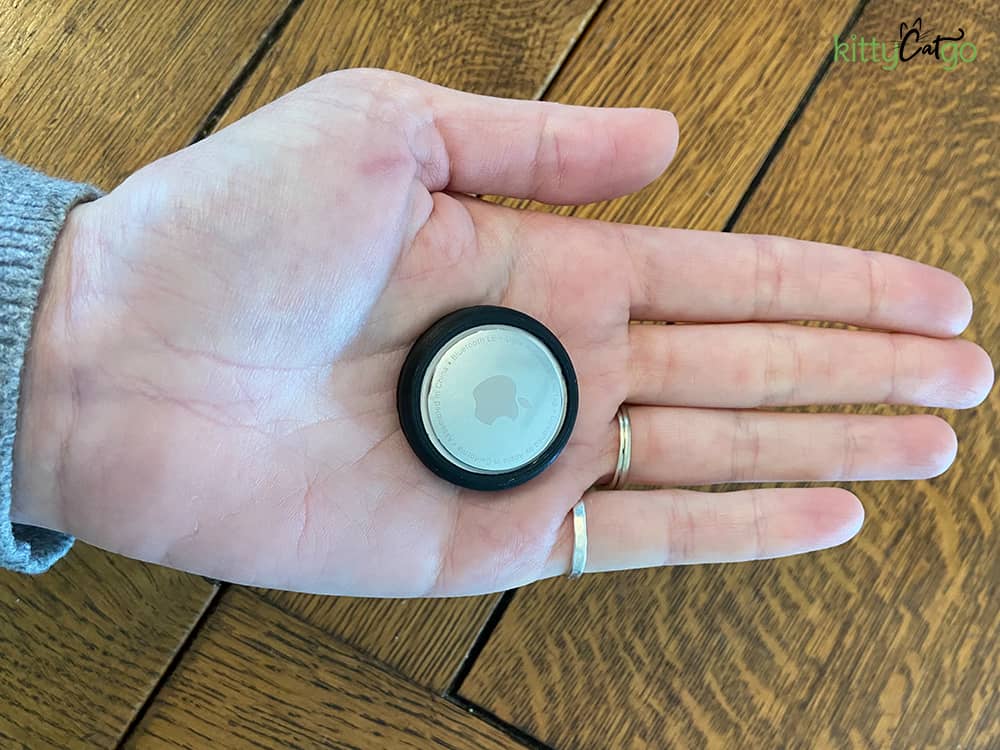
Tile Sticker Tracker
- Size: 1.06 x 0.31 in
- Weight: 0.17 oz
- Price: $23.99 – includes tag and collar attachment
- Range: up to 250 ft
Chipolo One
- Size: 1.49 x 0.25 in
- Weight: 0.27 oz
- Price: $25 – includes tag only
- Range: up to 200 ft
Features to Look for in a Tracking Device for My Cat
As mentioned, many of the cat tracking devices available offer more features and functions than simply tracking your cat’s location. Common features include:
- Live tracking which shows your cat’s location in real time and points you in the right direction as you search for your cat
- The ability to set “safe zones” so you receive notification if your cat ventures outside of the designated zone
- Location history so you can see where your cat has been
- Sleep tracking
- Activity tracking
- Health alerts if your cat’s sleep or activity levels have shown unusual changes
- A ring or vibration on their tracking tag which you can use to help locate your cat and even to train your cat to return to you when activated
- A flashlight on their tracking tag to make them stand out in the dark
- Family sharing so your friends, family, and pet sitters can track your cat’s location as well
It’s important to note that the GPS trackers are usually the ones with the most advanced features, such as location history and activity tracking.
Which features you need will depend on your situation. For example, if your cat is indoor only, you might not be concerned about location history since your cat doesn’t typically leave the house. Though you may be interested in tracking their sleep and activity levels.
If your cat roams outdoors, then having those safe zones and location history is probably important.

Is your cat meant for a life of adventure?
Let’s assess your cat’s personality to find out!
Which Type of Tracker Should I Get?
Again, the type of device you ultimately decide to go with will depend on your situation and your budget. However, here are some general guidelines that may help you with your decision:
Where a GPS tracker might be your best option:
- Your cat is a free-roaming, outside cat and you’d like to keep tabs on their comings and goings
- Your cat and you are spending a great deal of time on adventures where having a large range of coverage is definitely needed if your cat goes missing
- You live or adventure in areas with strong cell and/or internet service
When an RF tracker or Bluetooth tracker might be your best option:
- Your cat is primarily an inside cat, and the probability of them getting out and going far is low
- You know your search area is going to be small if your cat goes missing
- You simply need to be able to find your cat within your home or yard
- You live or adventure in rural areas where cell and/or internet service isn’t reliable
How to Attach a Cat Tracking Device
How you attach the cat tracking device will depend on which one you decide to go with. Some trackers, such as the Tractive, Weenect XS, Jiobit, Marco Polo, TabCat, and Girafus Pro-Track-tor, are either made to slide onto your cat’s collar or come with a case or mount that will then slide onto a collar. However, devices such as the AirTag or Chipolo One require you to purchase a third-party case or attachment device to be able to put it on a collar.
Some people opt to attach the tracking device to their cat’s harness instead of their collar. The tracker is less intrusive this way, and if your cat’s collar falls off (and their ID tags with it), then you can still rely on the tracker on your cat’s harness. However, a tracker on your cat’s harness does no good if they happen to slip out of their harness.
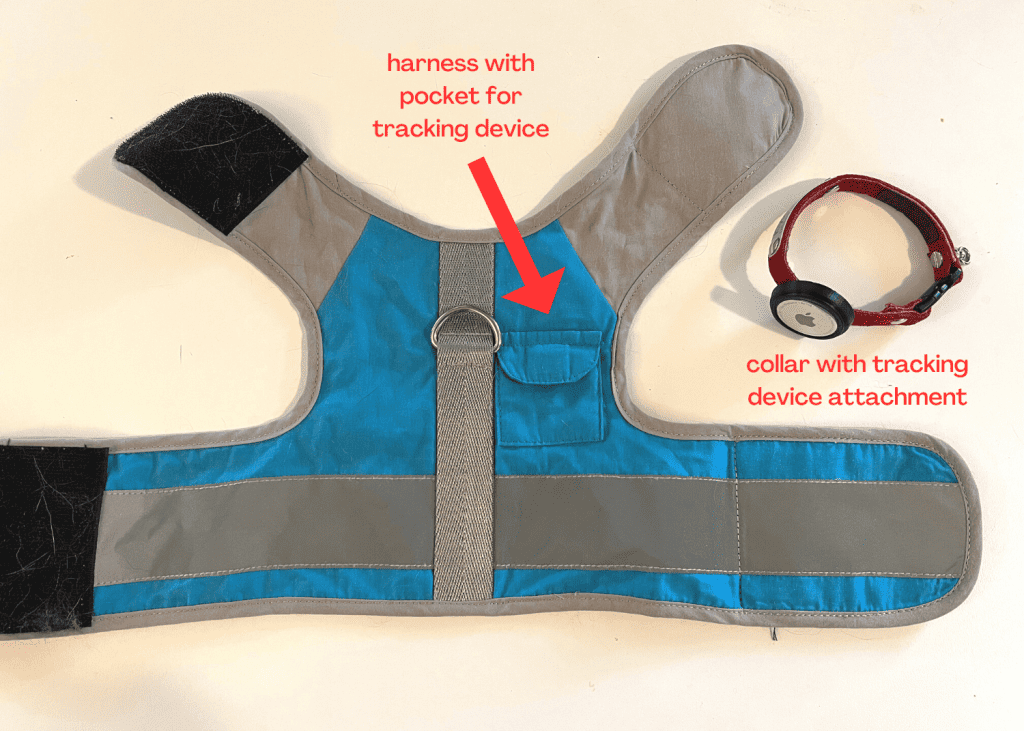
It’s up to you to weigh the pros and cons of attaching to a collar or harness and decide which option is best for you and your cat.
Cat Tracker FAQs
Is a cell signal necessary for a cat tracking device to work?
It depends on the device. Cell service and/or internet service IS required for GPS trackers to work. However, RF trackers do NOT require cell or internet service to function. Bluetooth trackers don’t require internet or cell service to show the last location, but AirTags use the Find My App to track, which does require internet or cell service.
What if I live in or go adventuring with my cat in rural areas?
If you live in or adventure in areas that typically don’t have great cell or internet service, a GPS tracker won’t do you much good. You might instead want to go with an RF tracker.
Which cat trackers work internationally?
Bluetooth and RF trackers can work anywhere. GPS trackers, on the other hand, might have an unlimited tracking range, but they don’t all work in every country. For example, the Jiobit only works within the US, the Weenect XS works in 37 countries, and the Tractive works in 175 countries.
What if my cat doesn’t tolerate having a tracking device on their collar?
Some of the tracking devices are bulky, which might be uncomfortable for some cats to have on their necks. If your cat isn’t accepting of the device at first, you can do some training and desensitization to encourage your cat to get used to having it on.
To do this, you would put the device on for very small increments of time to start (like 10 seconds). Give your cat treats and try to make the experience of wearing the tracker a positive one. Gradually increase the amount of time your cat wears it, continuing to give treats and encourage them to walk around and be active while wearing it. Repeat this process until your cat is always comfortable wearing the device.
If your cat doesn’t ever seem to get comfortable wearing a tracker, you can opt to attach it to their harness instead.
If I use a cat tracker, does my cat still need to wear ID tags or be microchipped?
None of the tracking devices will share personal information with other people, so it’s always best to have ID tags and a microchip in addition to the tracker. With each mode of identification that you add to your cat, you’re adding a layer of probability that they will be found and returned to you if lost.
ID tags are best if another person actually finds your cat. They can easily check your cat’s tags and contact you. Microchips are an excellent level of additional protection in case your cat loses their ID tags. Someone would be able to take your cat to the vet or animal shelter to check for a microchip and then be able to contact you.

About the Author
Emily Hall, ABCCT is a certified cat trainer and cat adventure enthusiast. As a “mom” to five cats and one dog, she has been writing in the pet industry for over 10 years, with a focus on traveling and adventuring with cats.
Emily has a passion for getting out there and doing more with her cats – for pushing the bounds of cat expectations! She and her husband enjoy hiking, road-tripping, camping, and canoeing with their three cat adventurers. Read more about Emily here.




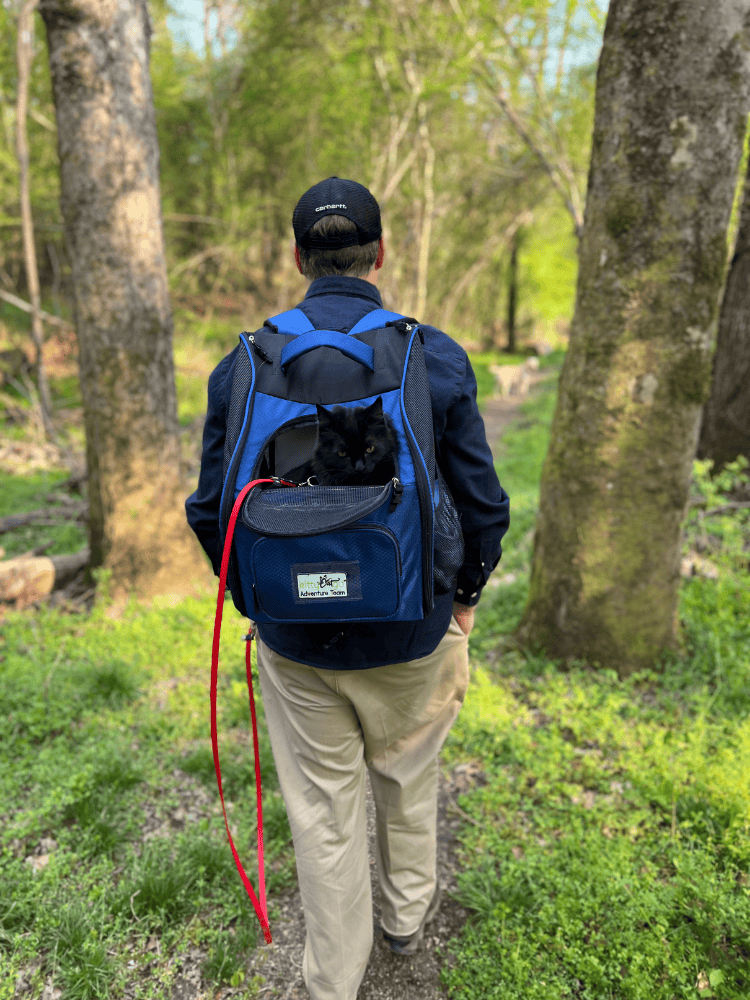


One Comment